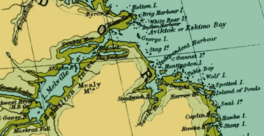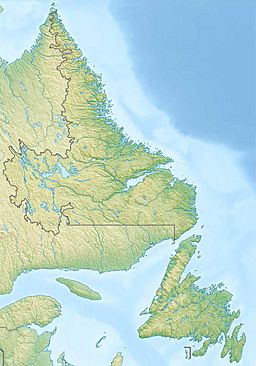Groswater Bay facts for kids
Quick facts for kids Groswater Bay |
|
|---|---|

A map of the Lake Melville/Hamilton Inlet/Groswater Bay system, showing Hamilton Inlet as inclusive of L. Melville and Groswater Bay as "Eskimo Bay"
|
|
| Location | south central Labrador, at the entrance of Hamilton Inlet |
| Coordinates | 54°20′00″N 57°39′57″W / 54.33333°N 57.66583°W |
| Native name | Kangerliorsoak Error {{native name checker}}: parameter value is malformed (help) |
| Basin countries | Canada |
Groswater Bay is a large bay located in south-central Labrador, Canada. It is also known by its Inuttitut name, Kangerliorsoak. This bay is part of a bigger water system that includes Hamilton Inlet and Lake Melville. Together, these waterways stretch about 140 kilometers (87 miles) inland from the coast.
Contents
What's in a Name? The Story of Groswater Bay's Names
Groswater Bay gets its name from a mix of French and English words. "Gros" is a French word meaning "fat," "thick," or "rough," and it's combined with the English word "water." This name likely came about because the area has been used for fishing for a very long time.
Over the years, Groswater Bay has also been known by other names. Some of these include Ivucktoke or Aviktok, which comes from the Inuttitut word Aivitok. Another name was Eskimo Bay (or Baie des Esquimaux in French), which refers to the Inuit people who have lived in the region for centuries. It was also sometimes called St Louis Bay (Baie-St Louis). Sometimes, these names were even used for Hamilton Inlet and Lake Melville too!
Wildlife: Birds of Groswater Bay
Groswater Bay is an important place for many birds, especially during nesting season. One common bird you might see here is the Common Eider. These are large sea ducks that often gather in big groups. They are known for their soft down feathers, which they use to line their nests.
A Glimpse into the Past: The Groswater Culture
Groswater Bay is so important that an ancient group of people is named after it! The Groswater culture refers to a group of Paleo-Eskimos. These were some of the earliest people to live in the Arctic regions of North America. They lived thousands of years ago and were skilled hunters and toolmakers. Naming them after Groswater Bay helps us remember where their history was first discovered and studied.
See also
 In Spanish: Bahía Groswater para niños
In Spanish: Bahía Groswater para niños 


